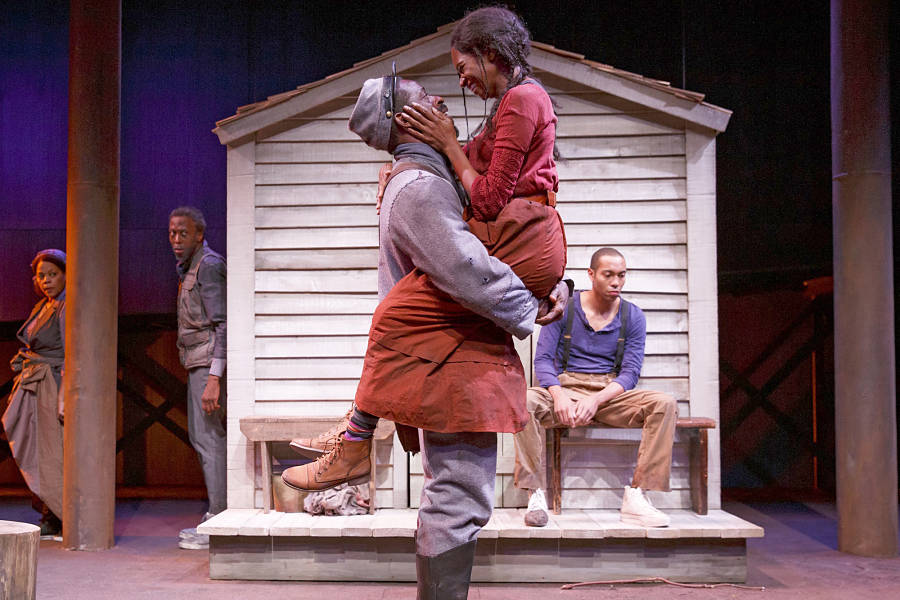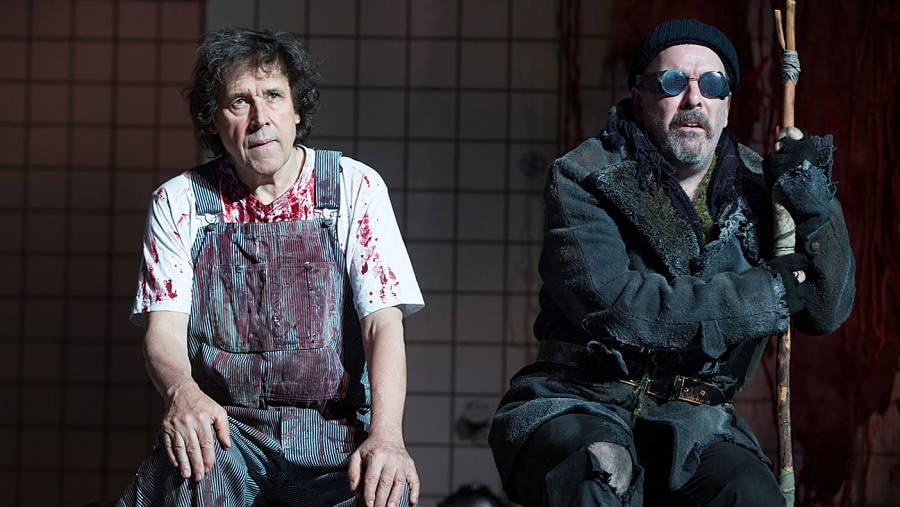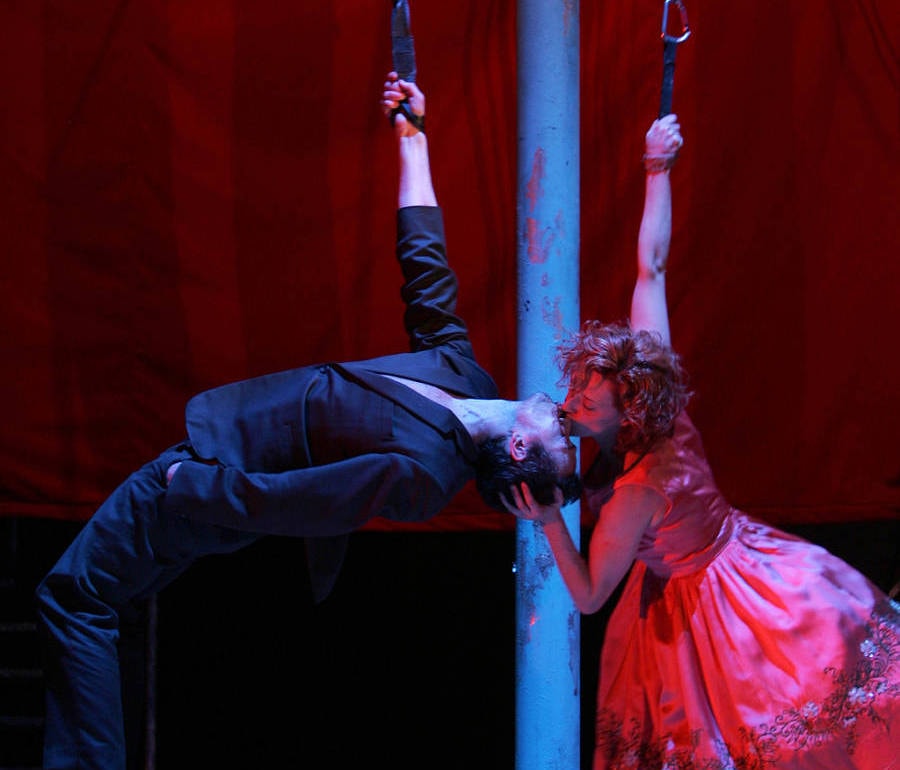“And he came to the place where three roads meet…”
No sooner do you hear those familiar words than, right on cue, your memory triggers the ancient story of Oedipus Rex and the crucial moment where the protagonist comes face to face with his destiny. No doubt the person sitting next to you in the audience remembers the story, too—after all, it’s the first Greek myth we all learned in school. This is one of those special, shared moments in the theatre, when together we brace ourselves for the cataclysmic events to come. The protagonist will collide with another traveler, lose his temper, kill him in anger… and the rest is tragedy. After all, it was preordained.
When contemporary playwrights turn to classical mythology, they unite their audiences in a similar shared experience. This is not a new phenomenon. What is new, however, are the innovative ways in which three particular playwrights this season have combined myths from one culture with another. The result? Three unique storytelling evenings in the theatre.
Suzan-Lori Parks’s Father Comes Home From The Wars (Parts I, 2 &3) was the first highly visible work last fall to draw deeply from mythology (it played at New York’s Public Theater last October through December, and the same production, directed vigorously by Jo Bonney, will be at Boston’s American Repertory Theater Jan. 23-Mar. 1). Parks has been reimagining and reinterpreting American history throughout her writing career. Her plays are saturated with images of the Civil War—note, for example, the recurrent appearance of Abraham Lincoln in The America Play, Topdog/Underdog and others. In 365 Days/365 Plays, too, Parks sketched out themes related to America and its wars, and from that prodigious work she drew the outline for her (planned) nine-part epic cycle.

The first trilogy of Parks’s Father cycle tells the stirring story of a slave named Hero (Sterling K. Brown) and his engagement in the Civil War. Part I, set in 1862 and titled “A Measure of a Man,” finds Hero struggling with the choice of going off with his “boss master” to fight with the Confederate troops, or remaining home with the other slaves. Part II (“A Battle in the Wilderness”) finds Hero on the front with his master, guarding their captive, a Union soldier named Smith. Again, Hero struggles with a choice: Should he escape with Smith and join the Union forces, or stay with the Colonel, his brutal master? Part III (“The Union of My Confederate Parts”) features Hero returning home from the war to face the yet-unknown consequences of Emancipation. “Seems like the worth of a colored man, once he’s made free, is less than his worth when he’s a slave,” Hero muses sourly.
What’s so special about Parks’ innovative brand of storytelling here is that she conflates American Civil War history with classical Greek mythology—specifically The Odyssey, Homer’s epic poem about a Greek hero’s perilous journey home from the Trojan War. Hero goes off to fight and returns with the name “Ulysses” (which also evokes the name of the famous Union general). Homer’s wife is named “Penny” (like Penelope, Ulysses’s wife). Even Hero’s dog has a classical name, “Odyssey Dog,” or “Odd-See” (and is given a show-stealing performance by Jacob Ming-Trent). Odyssey Dog, though he enters late, functions as a kind of Greek chorus, narrating the story of Ulysses’s homecoming while the “Chorus of Less Than Desirable Slaves” debates Hero’s fate. “Homer” is the name of Hero’s friend, whom he betrays in Part I by helping his master capture him when Homer tried to escape (Homer, in turn, forms an alliance with Hero’s wife in his absence).
This creative conflation of one myth with another (African-American with classical Greek) enriches Parks’s universal themes of the intrinsic value of a man, the essential meaning of freedom, the tragic complexities of war and the sanctity of human identity. “I belong to myself,” says Hero. But what will that mean after the slaves are freed? Stay tuned for Parts 4-9, to be presented at the Public in the future.
Over at Signature Theatre Center in midtown Manhattan, another playwright drew upon classical mythology to weave his tale. In this case, it was Sam Shepard, and he wove variations on the themes of Oedipus Rex, all soaked in blood, passion and mystery and titled A Particle of Dread (Oedipus Variations). This provocative production played more like an étude of the Oedipus story than a dramatic narrative. The “particles” of the title are fragmented scenes in no particular order. Some featured a compelling Stephen Rea as Oedipus (dressed in bloody workman’s clothes), in conversation and conflict with his wife/mother Jocasta and his father Laius. Others featured Oedipus’s daughter Antigone, in Shepard’s conception a contemporary police officer, who with a detective was investigating the crime that took place where those famous three roads met. Still other scenes included a “soothsayer”—the shepherd from the seminal myth, perhaps? These fragmented scenes were played on a huge white box-like set, its floors smeared with blood and walls decked with clotheslines from which blood-drenched garments hung.

In this case, the culture that Shepard transplanted and superimposed upon the classical Oedipus myth was an Irish one. Costumes were contemporary, accents Irish. Credit for this influence goes to lead actor Rea and his Irish theatre company Field Day, who commissioned the play from Shepard and premiered it in Derry. Shepard, who has been haunted by familial violence throughout his writing career (Buried Child, True West, The Late Henry Moss), happened to be working on the Oedipus stories at the time of the commission, and was struck by what he called the “corresponding” history of Northern Island’s “Troubles” to the sufferings depicted in the Oedipus story. As he explained in a program interview, he wanted to write about “family, fathers and sons, and murder. The situation of the contemporary characters are as horrific as the ancient ones.”
But rather than create a linear narrative, Shepard explored these themes in the unstructured, improvisational form of a musical fantasia, or a “jazz riff,” as director Nancy Meckler called it (the show was accompanied by a cello and guitar). The result was a thought-provoking if elusive study whose haunting questions about crime, fate and self-knowledge hung unanswered in the air.
Across the river in Brooklyn, the spirited Cornwall-based Kneehigh Theatre brought its newest immersive theatre piece, a take on a Cornish myth, Tristan & Yseult (the show is on a U.S. tour, with its next stop at Costa Mesa, Calif.’s South Coast Repertory ). Told in Kneehigh’s signature pastiche style, drawing from numerous theatrical vernaculars, the romantic story—immortalized by Wagner in his eponymous opera—deals with the ill-fated love between Tristan, a Cornish knight, and Yseult, an Irish princess promised to Tristan’s uncle, King Mark. While Tristan escorts Yseult to Cornwall for the wedding, the two drink a potion and fall hopelessly in love. The plot thickens with many twists and turns, including a surrogate bride who appears on the wedding night (so that Mark thinks Yseult is a virgin, etc.), and the King’s subsequent heartbreak when he discovers the betrayal.
Emma Rice, the endlessly inventive founder of Kneehigh, adapted and directed this enchanting tale, which entertains while at the same time conducting an earnest investigation into the meaning of love. The storytelling has a commedia dell’arte flair; it’s set in the “Club of the Unloved” and is hosted by the “Love-spotters,” a comedic corps of actors who caper around the theatre wearing Marmot all-weather jackets, goggles, jeans, sneakers and hoods, and who use “binoculars” to spot lovers in the audience and on the stage.
And the music is multicultural, from the familiar strains of Wagner’s score to Carmina Burana, from Russian folk music to Cornish/Irish rock played by the rollicking onstage band. You hear everything from Wagner’s “Liebestod” to “Dream Lover” and “Only the Lonely.” The choreography is equally kitschy, danced by Rice’s talented troupe and led by a dazzling Damon Daunno (as Frocin, King Mark’s aide). Frocin sports a gray business suit and dances a kind of mambo-salsa tango with an Elvis Presley gyrating hip twist. The result is a three-ring circus of storytelling, music, dance and acrobatic stunts, complete with trapeze swinging and balloons soaring through the house.
As for the serious side of love, the question of “What does true love mean?” is answered in one word: Immortality.
Looking back on past productions that have incorporated classical myths with modern ones, I’m reminded of the inspiring The Gospel at Colonus, the 1985 adaptation by Lee Breuer and Bob Telson, which told the story of Oedipus’s final days in the context of a Southern Baptist church ceremony, complete with a 60-member choir. That legendary production circled the globe, crossing the cultural boundaries with ease. “Europe meets Africa; classic meets contemporary, pagan meets Christian,” wrote the Village Voice of that Obie-award-winning production.
“Numberless are the world’s wonders, but none more wonderful than man,” sang the chorus in Gospel at Colonus. That also goes for a story that we all can share.


